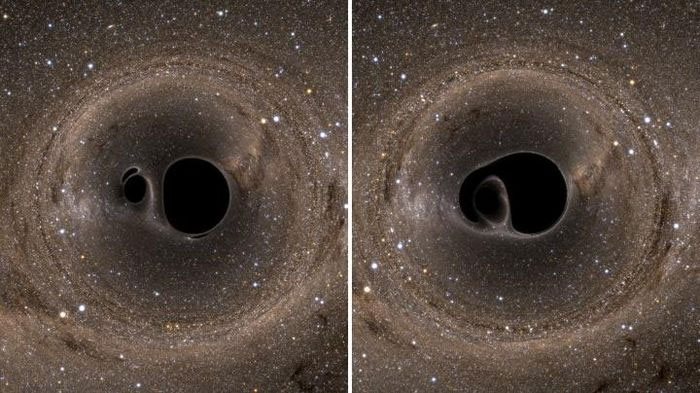Scientists announce new discovery about black holes
Scientists can now know what is going on inside a black hole and partly understand how this celestial body works .
According to the Independent , through a simulation model built on gravitational waves, scientists at the University of Mississippi can now tell you what is going on inside a black hole , the most mysterious celestial body in the universe.
Associate professor of physics and astronomy Leo Stein of the University of Mississippi and his colleagues have created a model that accurately simulates the gravitational waves produced when black holes collide and merge . The entire process can be partially observed as gravitational waves in spacetime after the collision.

Image of a simulated model of the merger of two black holes after collision. (Photo: Olemiss)
According to Independent, the merger of two black holes can be considered the most dramatic and special event that humans have ever known in the universe .
Physicists first demonstrated the existence of gravitational waves in 2015. Through gravitational waves, astronomers and specialized equipment can observe fluctuations in space-time when two black holes collide, creating waves that spread throughout the universe.
So far, gravitational waves have helped astronomers detect nearly 100 black holes that merged after collisions.
New research by Associate Professor Leo Stein has used those gravitational wave measurements to more accurately model cosmic events. That allows scientists to map the structure of what is happening inside black holes and test Albert Einstein's general theory of relativity in extreme regions of spacetime.
This research will also help future observations of black holes, as scientists discover more black holes colliding.
'This is a major step forward in preparing us for the next phase of gravitational wave detection, which will deepen our understanding of gravity and the unknown phenomena that occur in the distant parts of the universe,' said Macarena Lagos , co-author of the study.
The study by Associate Professor Leo Stein and colleagues was also published in the journal Physical Review Letters on February 21.
- Discover the mystery of the most exotic black holes in the universe
- Millions of black holes are hiding in our galaxy
- Decoding mistakenly thought that the black hole of the universe is
- Three huge black holes are about to collide in the universe
- A new discovery about the activity of a supermassive black hole in the early universe
- The galaxy has 3 black holes
- Detected stunned the power of the supermassive black holes
- The giant black hole in the Milky Way is just a mistake?
- The impact sound of two black holes: surprisingly gentle and melodious
- Why can black holes glow?
- Rare discovery of twin black superholes
- Unexpectedly discovered 5 mysterious black holes in the universe
 Van Allen's belt and evidence that the Apollo 11 mission to the Moon was myth
Van Allen's belt and evidence that the Apollo 11 mission to the Moon was myth The levels of civilization in the universe (Kardashev scale)
The levels of civilization in the universe (Kardashev scale) Today Mars, the sun and the Earth are aligned
Today Mars, the sun and the Earth are aligned The Amazon owner announced a secret plan to build a space base for thousands of people
The Amazon owner announced a secret plan to build a space base for thousands of people